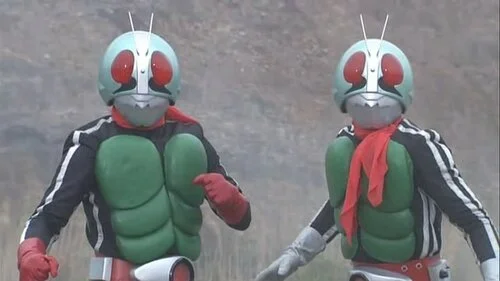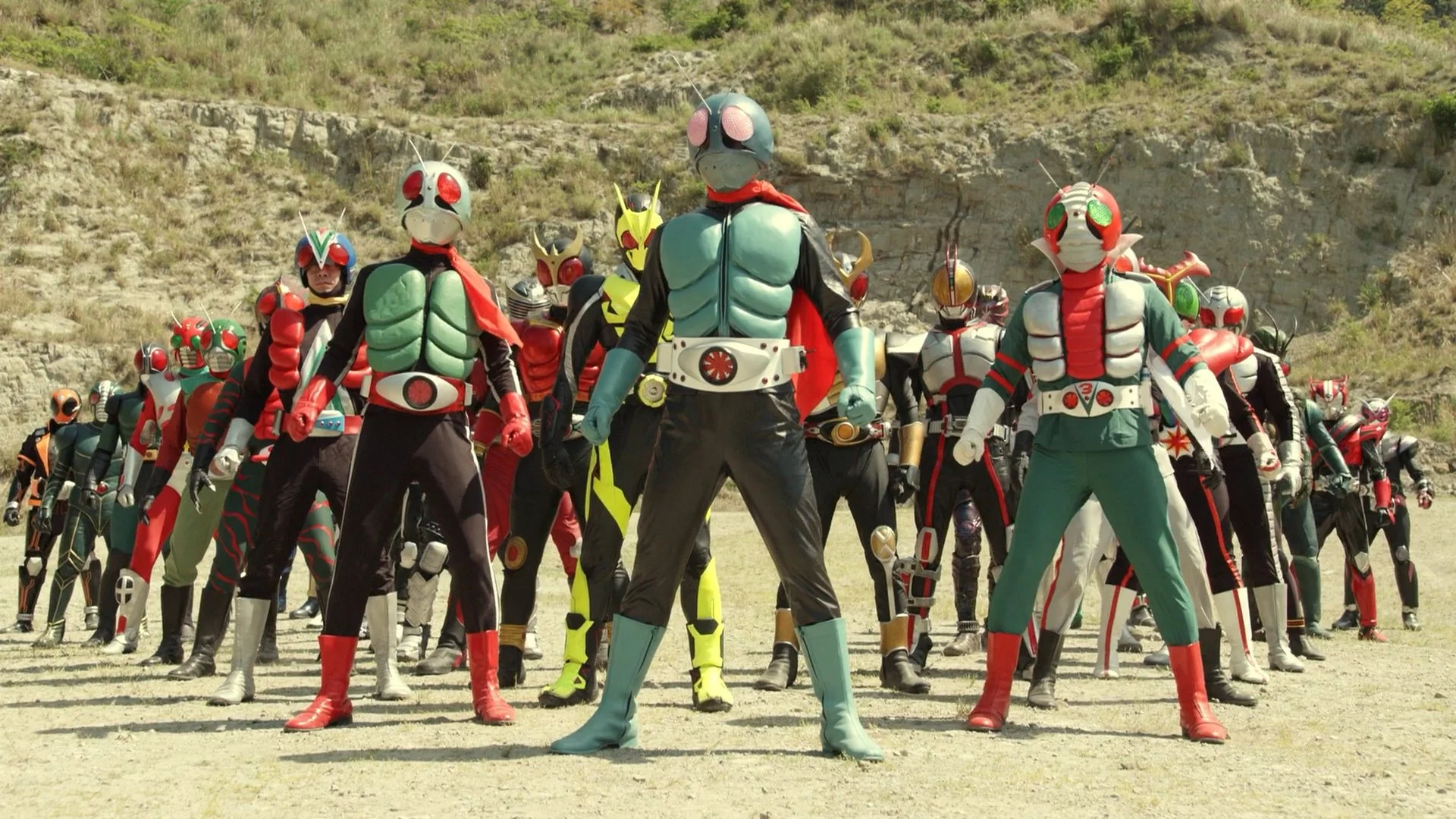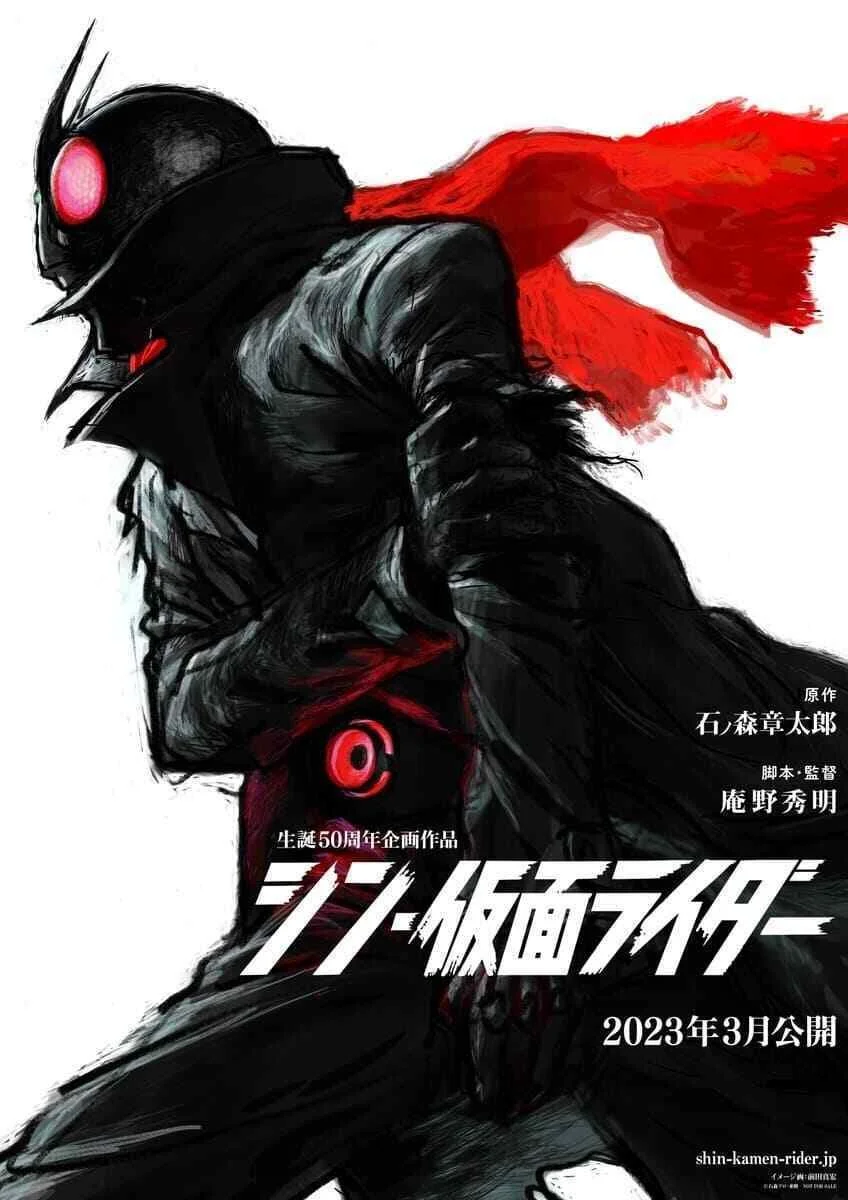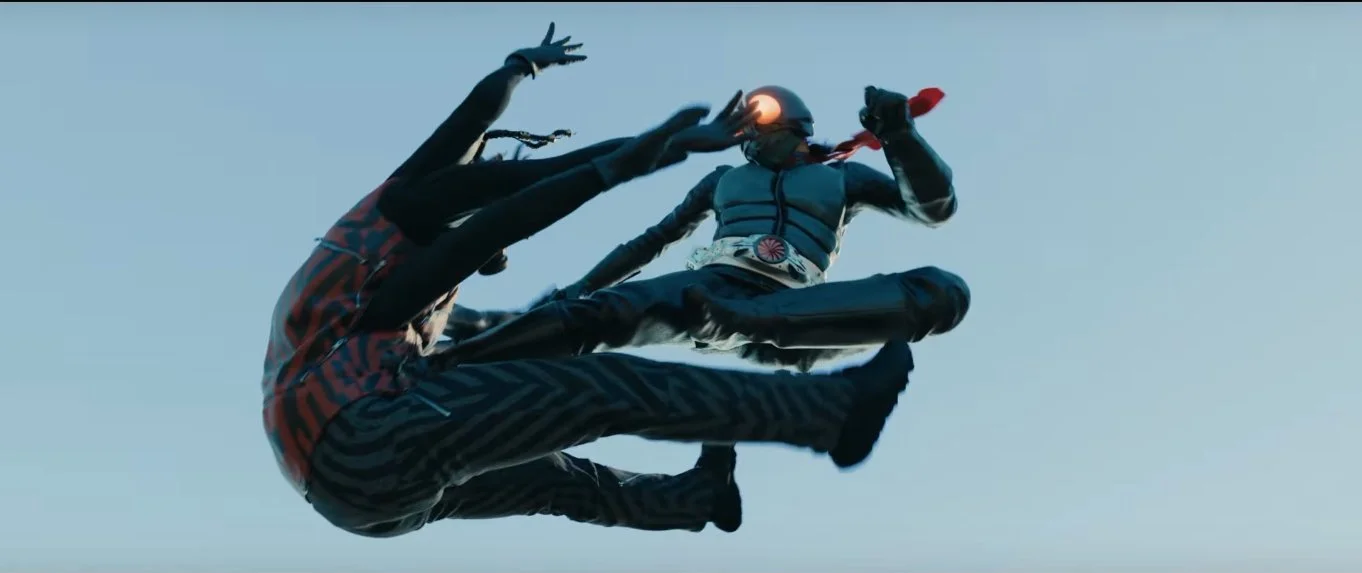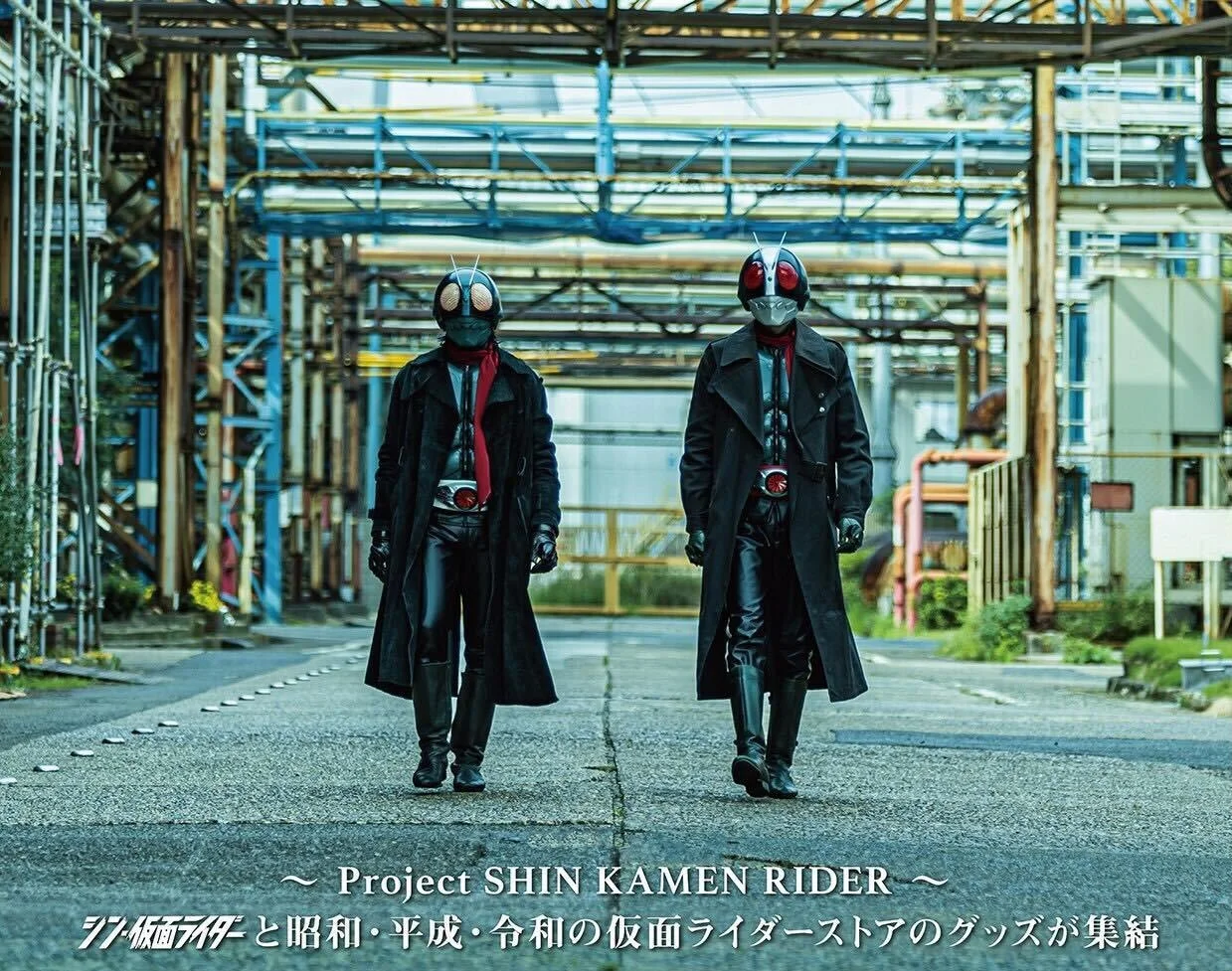Movie Review: Shin Kamen Rider
“Believe in him, won’t you? Even if there is no God or Buddha, there is still Kamen Rider” - Kamen Rider Spirits (2001)
One of Japan’s most beloved superheroes, the first Kamen Rider TV series aired in 1971. Based on the manga by Shotaro Ishinomori, Kamen Rider was a about a man named Takeshi Hongo who was abducted by an nazi-lite organization called SHOCKER and transformed into an insectoid cyborg meant to be their soldier for world domination. However, one of their scientists rebelled and freed him before he could be reprogramed. Now, cursed with a monstrous body and the knowledge of a secret evil with its hooks in every part of society, Hongo realizes that he is the only one capable of fighting back. Though he would much rather return to his peaceful life, he decides to dub himself “Kamen Rider” (“Masked Rider” in English) and rides off into the sunset on his motorcycle. Over the course of the series, he fights back against SHOCKER one monster at a time. Hongo is joined by trusted friends who help him investigate and, eventually, he is even joined by a second Kamen Rider, a man named Hayato Ichimonji, a freelance journalist who tried to investigate SHOCKER but was abducted and almost subjected to the same fate as Hongo. The Double Riders fight to ensure that peace, justice, and human life are always protected.
The Double Riders, then…
…and now.
In the past fifty years, there have been thirty-seven main Kamen Rider series released with a variety of takes on the original themes. In 2023, the current Kamen Rider is Kamen Rider Geats, a mysterious and cunning man taking part in a “Kamen Rider Game” where he fights monsters in order to have a wish granted. Despite some hiccups in production along the way, the franchise has endured and remained beloved by people of all ages. It is often consider to be a more “mature” counterpart to others in what has become known as the “tokusatsu” (special filming) genre such as Super Sentai and Ultraman. Instead of protagonists gifted with extraordinary powers and sent out to fight mean-spirited and blatantly evil monsters, Kamen Rider featured a protagonist who often saw himself as barely different from the monsters he fought. He would reflect on the tragedy of taking another’s life even if they were an enemy, but recognized that it was the only thing he could do to protect the innocent. The tone of each Kamen Rider series varies depending on who is working on it, sharing little besides a bug-eyed hero. They can be silly and lighthearted or grim and full of existential angst and moral ambiguity. However, each series in the franchise has its fans and they all promise an enjoyable time.
The legacy endures
Fast-forward to 2021, the fiftieth anniversary of Kamen Rider. As part of the celebration, Toei (the production company) announced several new projects celebrating everyones favorite bug-man. The highlight of those announcements was that Hideaki Anno, of Neon Genesis Evangelion fame, would be continuing what had become known as the Shin Superheroes Series with a new film Shin Kamen Rider. He had previously directed Shin Godzilla and Shin Ultraman with co-director Shinji Higuchi to wide critical acclaim, and would now be venturing out on his own to write and direct Shin Kamen Rider. The first trailer aired later that year on September 30th (my birthday!) which recreated the original opening of the series scene by scene with the film’s updated suit and motorcycle. Right from jump, the film promised to be a faithful retelling of the original story. In the year and a half after that trailer, only two more previews were released, both showing very little footage to indicate what the plot would be. Shin Godzilla and Shin Ultraman had both been about going back to the original versions of those long-running characters, exploring the tropes and themes they used, and reinterpreting them for the modern day while trying to stay true to the original. In particular, Shin Ultraman, itself inspired by a full series rather than a film, essentially boiled the original series down to a sequence of greatest hits woven together with an original plot. Would Shin Kamen Rider be something similar?
SPOILER ALERT: Full spoilers for the first two acts of Shin Kamen Rider follow.
Shin Kamen Rider beings in media res with a chase. Takeshi Hongo (played by Sosuke Ikematsu) has just been freed and is now racing for his life on his motorcycle in his Kamen Rider suit. Tagging along is Ruriko Midorikawa (played by Minami Hamabe). SHOCKER, reimagined as a science-cult pursuing immortality, has sent their minions after the duo. The pursuing party is led by Kumo-Aug 01 (Spider-Man in the original) who grabs Ruriko and surrounds Hongo with soldiers. Hongo has no choice left but to fight and lashes out at one of the grunts, striking him in the head. The grunt’s head explodes, spraying blood and leaving our hero drenched in it. He proceeds to deal with the rest in kind, leaving a bloody mess behind him. Shortly thereafter, he is in a safe house, trying to wash the blood from his gloves. He takes them off only to see that his hand has become scaly and clawed. Panicked, he forces his helmet off and beholds a scarred face with red eyes. It’s at that moment that he truly realizes that he’s been turned into a monster. He is quickly filled in on the nature of SHOCKER and that he’s been transformed into Batta-Aug 01 (“batta” being japanese for grasshopper). As mentioned before, SHOCKER is now a cult pursuing immortality. They are doing this through the use of a natural life energy called “Prana” (nebulously based on the Hindu concept of the same name) which every human possesses and what grants the film’s super-humans their powers. Hongo is asked by Professor Midorikawa to fight back against the organization and it’s enigmatic leader. Ruriko then walks up to him, ties a red scarf around his neck and asks him to become “Kamen Rider”. To say Hongo is unsure is an understatement. He is still reeling from his transformation and what he’s learned when the professor is struck down by Kumo-Aug and Ruriko is abducted once again. Still unsure, but unable to turn away from someone in need, Kamen Rider gives chase, rescues Ruriko, and dispatches Kumo-Aug with his new abilities.
From man to monster
The pair are contacted shortly after by two government men who go unnamed for most of the film though eventually they are revealed to be new takes on two mainstays of the original series. They are played by Yutaka Takenouchi who played one of the main characters of Shin Godzilla and had a small cameo in Shin Ultraman and Takumi Saitoh who, inversely, played a small role in Shin Godzilla and was the lead in Shin Ultraman. These two men are responsible for the fight against SHOCKER and serve as mission control for Ruriko and Hongo. What follows is our reluctant hero and heroine being sent around Japan to the various SHOCKER bases to defeat the super-humans leading each one. The leaders are all updated versions of classic Kamen Rider villains, though their actual villainousness varies. The Koumori-Aug (Bat-Man in the original and played by Toru Tezuka here) is gleefully malicious while the Hachi-Aug (Bee-Woman in the original and played here by Nanase Nishino) puts up a callous facade but is shown to be more conflicted about her actions. During these missions, Hongo learns more about Ruriko and how she’s ended up in her current situation. He becomes more willing to fight, but he never stops trying to talk his opponents down before it’s too late.
Promotional poster showing Hongo and Ruriko
After they’ve dealt several blows to SHOCKER, they make an attempt at taking down their leader. In the original, the “Great Leader” was a masked figure in a red cape who sought world-domination for its own sake. Here, the leader (played by Mirai Moriyama), is a stoic cult leader clad in white. He is also Ichiro Midorikawa, Ruriko’s older brother, who is now driven by tragedy rather than greed. Ichiro is served by an android named “K” (a homage to Robot Detective K, another Ishinomori series.) and protected by Batta-Aug 02, Hayato Ichimonji (played by Tasuku Enomoto) who has been brainwashed into a loyal agent of SHOCKER. He possesses superior versions of all of Hongo’s abilities and keeps a steady advantage during their fight. He is only stopped by Ruriko’s intervention which frees him of his brainwashing. After some soul-searching, he joins Hongo in the final assault on Shocker.
HENSHIN!
As with the previous two “Shin” films, Shin Kamen Rider is a back to basics look at the original. It strips back the lore and history and gives the audience a man who has been horrifically transformed, but has gained great power and the ability to stop others from experiencing the same fate. Hongo is shown to be an intelligent man, but he is not some kind of super-genius who can figure out a perfect resolution to the problems he is presented with. He is put into life-or-death situations and does the best that he can. The film does not shy away from blood and the fights against the armies of faceless grunts make the audience feel as unsettled as Hongo. It’s a dirty business and we mourn our hero for being the one who has to do it. While Hongo is rarely successful in trying to talk his enemies down, it is still important that he does so as it keeps him from becoming a monster just like the ones he is fighting. When he actually does manage to be successful, it proves to be incredibly rewarding for him and more than makes up for all the failures. He is shown to be correct for always offering his hand. That said, the fights against the other “Augmented Humans” are a spectacle to behold. As one might expect from a series from 1971, the effects don’t necessarily hold up. Rather than turn away from that, Anno emphasizes it in the fight choreography. The film uses CG to replicate the janky wirework of the original. For the most part, it helps illustrate how heightened these super-humans are as they jump around industrial areas and exchange blows in mid-air. The film also uses rapid-fire cuts in the action sequences to give the impression of speed much like the original did. There are specific references to sequences from the original that are recreated in all their awkward glory. Compared to many modern superhero films which strive for more realistic action or at least something which adheres more closely to the laws of physics, Shin Kamen Rider happily does twenty backflips over the laws of physics before twisting into a flying kick. Fans of the original will clap their hands in delight, but some of the scenes might be off-putting to viewers without that background knowledge. One of Shin Ultraman’s flaws was that it was sometimes too easter-egg heavy. There were entire scenes which were incomprehensible without understanding what was being referenced. Compared to that, Shin Kamen Rider balances the references much better. There are still plenty of shout-outs for long-time fans, but they serve the story without that background context as well. There is a major injury that Hongo suffers later in the film which referenced a behind-the-scenes injury Hiroshi Fujioka (the actor who played Takeshi Hongo in the 1971 series) suffered which necessitated the introduction of a replacement Kamen Rider. It was a dramatic moment in the film, but it may be distracting to fans who recognize what’s about to happen. You can imagine the gleam in Anno’s eye when he was writing that scene and part of the fun for longtime fans is going to be seeing how many references he can fit into the story. It feels very much like a film written by a fan for the fans.
Rider… Kick!
The characters, much like in Anno’s other two films, are completely focused on the plot. They have no personal lives, no jobs to juggle, no rent to pay. For the most part we only learn about their personal histories in regards to how they affect the characters’ current situations. The film centers almost entirely around Ruriko and Hongo, and given her family ties to SHOCKER, Ruriko’s history is given greater importance by the story. In the original series, she is still the daughter of a SHOCKER scientist, but has no other ties to the organization. She is innocent and acts a link between Hongo and humanity. Here, she is a scientist whose hands are implied to be as dirty as Hongo’s. She is motivated by the same tragedy as her brother but, unlike him, she begins to identify how harmful and out-of-control their obsession has become. She is more stoic than her original counterpart, and much more willing to jump into the fray, but she still manages to serve as Hongo’s moral compass. The main arc of the film is them slowly opening up to one another and deciding together what it means to be a Kamen Rider. By the time they’ve started to figure it out, they are joined by Hayato Ichimonji. A cocky jokester compared to the brooding but empathetic Hongo, he provides a fun contrast. Though he seems more excited by his newfound superpowers, he is still shown to be affected by the mental scars SHOCKER inflicted on him. Our other main characters are the two mysterious g-men. While they clearly want to stop SHOCKER as much as our heroes, they are shown to be much more pragmatic about it and are less willing to give their enemies a second chance. Despite that, they prove to have Hongo’s and Ichimonji’s backs when it counts. The majority of the villains’ characterization is pretty thin. We have a mad scientist, two assassins who love murder, and a sadistic psychopath. The two most interesting villains are the Hachi-Aug and Ichiro Midorikawa. Hachi-Aug was once Ruriko’s friend before she was changed, and a key part of Ruriko’s arc involves her trying to bring her friend back. Unlike the other villains, the audience actually gets to see some of who Hachi-Aug is beneath the mask and what pushed her to become what she has. It gives her fight with Kamen Rider more weight than a simple “hero vs villain”. Ichiro also makes for a fascinating big bad. Initially portrayed as having become completely devoid of humanity, he appears almost alien in the way he moves. Every action he makes, even something as simple as crossing his legs, is dance-like and deliberate. As Hongo and the audience come to understand his past, however, we see a man tormented by loss and desperate to prevent it from happening again. In this way, he becomes an excellent foil for our heroes and their final showdown becomes as much an idealogical one as a physical one.
“When an era needs it, Kamen Rider will definitely return.” - Shotaro Ishinomori
All in all, Shin Kamen Rider is an excellent film and an enjoyable experience regardless of one’s prior knowledge of the franchise. In a media landscape oversaturated with superhero stories, the film provides a distinct and refreshing flavor. It’s not perfect, as there are plenty of pacing issues and a few too many easter-eggs at the expense of the plot but none of those issues bog the film down too much. The action was sometimes too CG heavy as well and may be off-putting to some viewers especially if they are unfamiliar with the source material. The film still manages to be a thoughtful re-imagining of one of Japan’s most classic superheroes. A solid 8/10 overall. While the story is grim and violent throughout, it is saved from being “grimdark” by a message of hope, showing how actions can inspire others and lead to more good deeds down the line. It is the rare action-thriller that actually makes an effort not to glorify violence and gives us a hero as human as we are. By the time the story is finished, perhaps you too will believe in Kamen Rider.
